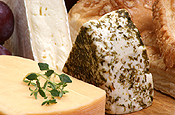Wine region
» Carnuntum
» Kamptal
» Kremstal
» Mittelburgenland
» Neusiedlersee
» Neusiedlersee/Leithab.
» Oberösterreich
» Südburgenland
» Südsteiermark
» Thermenregion
» Traisental
» Vulkanland
» Wachau
» Wagram
» Weinviertel
» Weststeiermark
» Wien
» Carnuntum
» Kamptal
» Kremstal
» Mittelburgenland
» Neusiedlersee
» Neusiedlersee/Leithab.
» Oberösterreich
» Südburgenland
» Südsteiermark
» Thermenregion
» Traisental
» Vulkanland
» Wachau
» Wagram
» Weinviertel
» Weststeiermark
» Wien
Weinart
Inhalt
Alkoholgehalt
Cheese:

Fresh, crusty bread, a nice selection of cheeses and to a good wine. For many, that's exactly the epitome of "savoir vivre". But you combine wine and cheese according to which criteria? The personal taste is absolutely essential, but there is also here a few rules of thumb that can help you the composition of wine and cheese. On closer inspection cheese and wine have much in common: a centuries-old tradition, similar manufacturing processes and quality control, common consumer events and a positive effect on our health. For the taste of wine, location of the vineyards, grape and treatment of grape juice and wine play a crucial role.
In ageing cellars, a cheese can ferment up to five times. In the first stage turns lactose to lactic acid. The cheeses get so a slightly sour, spicy taste. Typical examples are cheese, cottage cheese, Petit Suisse, Quark, Trockener, no longer quite young Riesling with not too much alcohol, young Silvaner or Müller-Thurgau are acceptable additions to these cheeses.
Secondly protein into amino acids and their degradation products can be broken down in parallel. This gives rise to a strong, very aromatic taste. Examples are: dry - not too young - is a good companion of how Grüner Veltliner from Austria.
Lactic acid is partially mined in propionic acid in a third fermentation process. This gives rise to the characteristic taste of Emmentalers which has some sweetness and can be accompanied by a säurearmen, not grape white wine Chardonnay.
In the Group of white mould cheese, the bark is the most flavour intensive part. Therefore, the wines must harmonize with the mold flora that tastes most of mushrooms. This succeeds best with fruity, but not too acid intensive white wines without age in oak. This is the domain of white, Chardonnay and Pinot Gris.
Alle Preise in EURO inkl. gesetzlicher Steuer und zzgl. Versand.
© 2018 - Onlineshop von web2future.at










